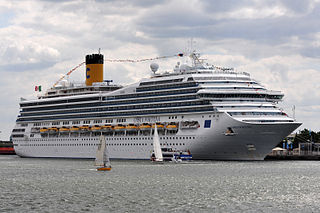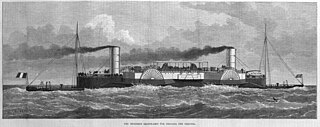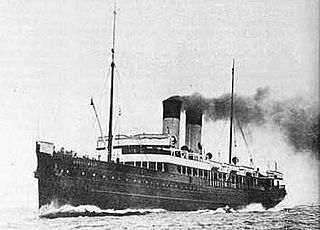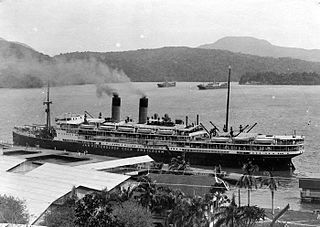
SS Great Britain is a museum ship and former passenger steamship that was advanced for her time. She was the largest passenger ship in the world from 1845 to 1853. She was designed by Isambard Kingdom Brunel (1806–1859), for the Great Western Steamship Company's transatlantic service between Bristol and New York City. While other ships had been built of iron or equipped with a screw propeller, Great Britain was the first to combine these features in a large ocean-going ship. She was the first iron steamer to cross the Atlantic Ocean, which she did in 1845, in 14 days.

USS Charger (CVE-30) was an escort carrier of the United States Navy during World War II converted from a commercial C3-P&C cargo/passenger liner hull built as Rio de la Plata intended for the Moore-McCormack company's American Republics Line serving the east coast of South America. The ship was requisitioned for conversion to an escort carrier type intended for Royal Navy use and initially commissioned as HMS Charger (D27). Days later the transfer was rescinded with the ship returning to U.S. Navy control to become USS Charger which operated throughout the war as a training ship on the Chesapeake Bay with two ferry missions to Bermuda and Guantánamo Bay, Cuba.

Sir Charles Vyner Brooke, Rajah of Sarawak, full name Charles Vyner de Windt Brooke was the third and last White Rajah of the Raj of Sarawak.

The Bangka Island massacre was the killing of unarmed Australian nurses and wounded Allied soldiers on Bangka Island, east of Sumatra in the Indonesian archipelago on 16 February 1942. Shortly after the outbreak of World War II in the Pacific troops of the Imperial Japanese Army murdered 22 Australian Army nurses, 60 Australian and British soldiers, and crew members from the Vyner Brooke. The group were the only survivors from their steamship which had been sunk by Japanese bombers just after the defeat of Singapore. After surrendering to local Japanese forces on Bangka Island, which was then part of the Dutch East Indies, the group and its wounded were taken to a beach where they were killed by being bayonetted and machine gunned in the surf. Only South Australian nurse Sister Lieutenant Vivian Bullwinkel, American Eric Germann and Royal Navy Stoker Ernest Lloyd survived.

The White Rajahs were a hereditary monarchy of the Brooke family, who founded and ruled the Raj of Sarawak as a sovereign state, located on the northwest coast of the island of Borneo in Maritime Southeast Asia, from 1841 to 1946. Of British origin, the first ruler, James Brooke was granted the province of Kuching – which was known as Sarawak Asal – by the Sultanate of Brunei for helping fight piracy and insurgency among the indigenous peoples in 1841 and received independent kingdom status.

Costa Fortuna is a cruise ship for Costa Crociere built in 2003 on the same platform as Carnival Cruise Lines' Destiny class. She was inspired by the Italian steamships of the past. Models of these ships are on display in the ship's public areas. In the atrium, models of the 26 past and present ships of Costa's fleet are displayed upside down, on the ceiling, up to, and including, Costa Fortuna herself. She was refurbished between 10 and 16 December 2018 in Singapore and was re-positioned back to Genoa, Italy in March 2019.

The Raj of Sarawak, Kingdom of Sarawak or State of Sarawak, was a kingdom founded in 1841 in northwestern Borneo and was in a treaty of protection with the United Kingdom from 1888. It was formed from a series of land concessions acquired by the Englishman James Brooke from the Sultan of Brunei. Sarawak was recognised as a sovereign state by the United States in 1850, and by the United Kingdom in 1864. Since the formation of Malaysia on 16 September 1963, The Raj has been a constitutent state of Malaysia as the state of Sarawak.
The West Cornwall Steam Ship Company was established in 1870 to operate ferry services between Penzance, Cornwall, and the Isles of Scilly. It became the West Cornwall Steamship Company in 1907 and was wound up in 1917.

Bonnington was a sternwheel steamboat that ran on the Arrow Lakes in British Columbia from 1911 to 1931. Bonnington and two sisterships were the largest sternwheelers ever built in British Columbia. Bonnington was partially dismantled in the 1950s, and later sank, making the vessel the largest freshwater wreck site in British Columbia.

SS Manchuria was a passenger and cargo liner launched 1903 for the San Francisco-trans Pacific service of the Pacific Mail Steamship Company. During World War I the ship was commissioned 25 April 1918–11 September 1919 for United States Navy service as USS Manchuria (ID-1633). After return to civilian service the ship was acquired by the Dollar Steamship Line in 1928 until that line suffered financial difficulties in 1938 and ownership of Manchuria was taken over by the United States Maritime Commission which chartered the ship to American President Lines which operated her as President Johnson. During World War II she operated as a War Shipping Administration transport with American President Lines its agent allocated to United States Army requirements. After World War II, she was returned to American President Lines, sold and renamed Santa Cruz. The liner was scrapped in Italy in 1952.

The SS Bessemer was an experimental Victorian cross-channel passenger paddle steamer with a swinging cabin, a concept devised by the engineer and inventor Sir Henry Bessemer, intended to combat seasickness.

SS Stella Solaris was an ocean liner built for Messageries Maritimes in 1953. She mainly provided passenger service between France, the Middle East, Southeast Asia, and Japan.

SS Empress Queen was a steel-hulled paddle steamer, the last of her type ordered by the Isle of Man Steam Packet Company. The Admiralty chartered her in 1915 as a troop ship a role in which she saw service until she ran aground off Bembridge, Isle of Wight, England in 1916 and was subsequently abandoned.

SS Sirius was a Norwegian iron-hulled steamship built in Germany in 1885. Sirius spent over 55 years sailing with cargo, regular passengers and tourists between Norway and Europe, and on the Norwegian coast. In 1894-1895, she served a year on the Hurtigruten route on the coast of Norway, before reverting to her former duties.

SS Copenhagen was a North Sea passenger ferry that was built in Scotland in 1907. She was the Great Eastern Railway (GER)'s first turbine steamship. In 1916 she was requisitioned as an ambulance ship. A U-boat sank her in 1917 with the loss of six lives.

SS Jan Pieterszoon Coen was a Dutch passenger steamship that was launched in 1914. She was named after a former Governor-General of the Dutch East Indies. During the German invasion of the Netherlands in May 1940 she was scuttled as a blockship in the port of IJmuiden, North Holland to prevent the Kriegsmarine from using the port.

Suwa Maru (諏訪丸) was a Japanese passenger/cargo ship owned by Nippon Yusen Kaisha (NYK). The ship was launched in 1914 by Mitsubishi Shipbuilding & Engineering Co. at Nagasaki, Japan. The ship was named for the Suwa Jinja, a noted Shinto shrine located in Suwa, Nagano. In July 1941 the ship was taken into military service, and after being struck by torpedoes was beached on Wake island in the Pacific in 1943. Since it was able to beach there was not much loss of life, though the ship was later struck again a few months later and the wreck visible for many years after the war.

Ramage & Ferguson was a Scottish shipbuilder active from 1877 to 1934, who specialised in luxury steam yachts, usually with steel hulls and timber decks. They also made several notable windjammers, including the five-masted København.

SS Op Ten Noort was a passenger steamship that was launched in the Netherlands in 1927. She was built for the Koninklijke Paketvaart-Maatschappij, who operated her in the Dutch East Indies. Op Ten Noort was named after the founder of KPM, Laurens op ten Noort.

Unyo Maru No. 2 was a Japanese cargo ship. Launched in 1937, the ship was requisitioned by the Imperial Japanese Navy in November 1941, a month before the outbreak of the Pacific War. The ship was assigned as a transport and took part in the landings at Sarawak and Kuching, delivering supplies and equipment. On 26 December 1941, while off Kuching, Unyo Maru No. 2 was attacked by Dutch Air Force bombers; the cargo ship was sunk with the loss of eight crew aboard.


















